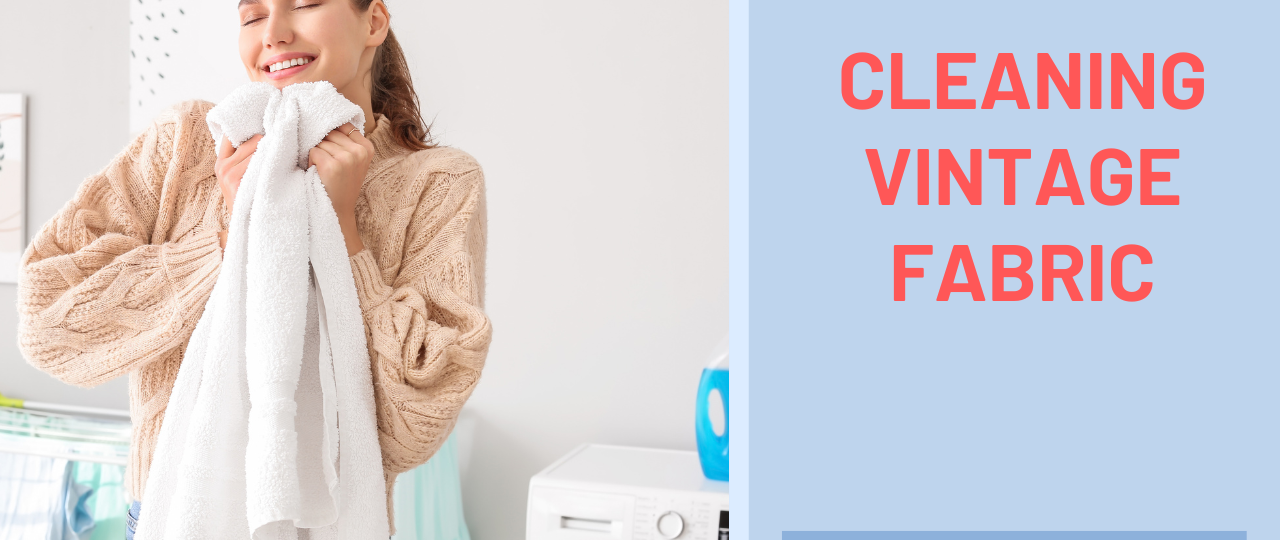Unless you spend quite a bit of money on vintage clothing, linen or other fabrics, or just happen upon a great treasure, usually the items you'll find have quite a bit of wear on them. Since there usually isn't sentimental attachment to these purchased items, it's easier to take a chance and try cleaning them. If it's a piece of clothing that isn't suitable to wear any longer, consider making pillows, doll clothing or crafts with it. I never turn down a bargain on vintage fabric, trim, buttons or lace!
GENERAL CLEANING TIPS
First tip--don't use your washing machine or dryer. Old fabrics are just too fragile and need individual attention. Start with a simple soak in cool water and a mild soap. Soak all day or let it soak overnight. Swish it around in the soapy water but don't rub. Rinse the item three or four times in cool water. Don't wring out the water. Squeeze VERY gently then use thick towels and gently pat the item dry. Lay it flat on a dry towel, out of the sun. Once it's dry, look it over. You may not need to do anything else. If it's stained you can try a few other methods. If you are cleaning old lace or trim--do the same thing, but take a paper towel tube or something shaped like it, and wrap it with a dish towel, then gently wrap the trim or lace around it and allow it to dry. You can store it on an empty ribbon spool or paper towel tube as well once it's dry, but wrap the spool first with acid-free paper.
OxiClean (powdered variety) is another cleaner that will remove many stains. It needs to be dissolved in very hot water though, so first add the powder to hot water, stir and then add some cool water to it before using it on the fabric. On especially dirty linen you can actually simmer the fabric in a large pot full of water for an hour or two. This will work for items like tablecloths, napkins, pillowcases, etc. that are too stained or soiled to use. Hang them outside in the sun to dry---that also may help bleach out some of the stains. Note on the OxiClean---it foams and tends to boil over so use a very large pan and don't fill it to full.
On other pieces of clothing you can soak just the stained area in the OxiClean...dissolving it first---if the fabric seems fragile then soak it 15-30 minutes in a bucket or dish pan and rinse with cool water. Dry flat and when dry check to see if the stains are gone. If not, try again. If an item have embroidery on it, be very careful because the colors may run. Test a very tiny spot first. You can make a paste out of the OxiClean too, and place it on the spot or area.
OxiClean and the products from other companies that are the same type of thing are actually sodium percarbonate or "oxygen bleach". When you add water to the powder it "activates" it and it will stay active for 6 hours or so. Do not try to reuse it or put it in a container. Make it up as you need it. DO NOT use on wool or silk. Clorox Oxi Magic warns not to use it on nylon, silk or wool. Also, do not use on anything that has metallic paint, thread or anything similar. It interacts with it and can damage the fabric. It will not remove rust stains. Biz stain remover is a good one to use when you can't use one of the "oxi" products. It's considered an "enzyme" cleaner and works well on stains.
SPECIAL FABRICS
Notes on Silk: it comes in a variety of cloth types: broadcloth, chiffon, crepe de chine, georgette, noil, silk linens, tweed and silk blends. Dry cleaning is recommended for patterns that have many colors---if hand-washed the colors may run. Light colors or whites may be hand-washed in warm water. Always roll silk in a towel, never wring it out or put it in the dryer. It also can be damaged if it is ironed on too high of a setting. Cover it with a cloth and use a steam iron it if it needs ironing. Silk also shouldn't be dried in the sun or displayed where it has direct sunlight on it. After washing, rinse in cool water to which a teaspoon of vinegar has added to remove the soap. Roll the item in a towel to soak up the moisture and lay it flat to dry. A mild liquid castile soap can be used, a mild shampoo, or use something made especially for washing silk. Don't use regular detergents, hot water, any type of heat and never use bleach. To remove yellowing from pale color silks, you may add 3 tablespoons of white vinegar to a basin of cool water and gently soak and swirl. Dry as above.
Notes on wool: Big controversy on hot water versus warm or cool water. To be safe, use lukewarm water---wool doesn't like any type of temperature change. So rinse in the same temperature that you wash in. Squeezing, rubbing, wringing or ANY type of roughness is out. For soap use a ph neutral soap--anything from Dawn original dish soap, liquid Tide or even a gentle shampoo. "Swish" the wool item VERY gently. Rinse well, and lightly squeeze to remove some of the water, but don't wring it at all. Dry flat on a towel, out of the sun.
Notes on doilies and crochet pieces: Liquid starch can be used on doilies that are being displayed or used in your home to protect against spills and use. After dipping the doily in a liquid starch solution lie the doily flat on several layers of dry towels. Align all of the corners and sides if the piece is rectangular or square- this is called "blocking". The same process is used for crochet items such as tablecloths and bedspreads. You can lay large pieces on cotton blankets outside using the same process. You should never hang crochet pieces to dry.
Notes on lace: It used to be that it was suggested you dry lace in the sun to bleach out any stains, but I've seen several things now that suggest this may damage the fibers in the lace. It's actually better to leave the yellowing---it will look aged, much like when people use tea dyes and that type of thing, to give fabric an aged look. You can wash lace with a very mild detergent. Pat out the water with a towel or soft cloth rather than wringing it.
Any of the fabrics above should be stored flat and gently wrapped in acid-free paper...never any type of plastic, and don't allow them to touch a wood surface while being stored either. Never store any vintage item on a hanger. If you follow these suggestions your vintage fabrics should be kept in good shape. But remember, get them out, enjoy them, use them--and share them:)




















